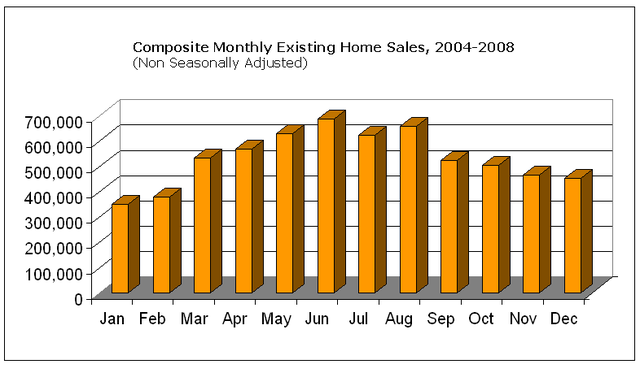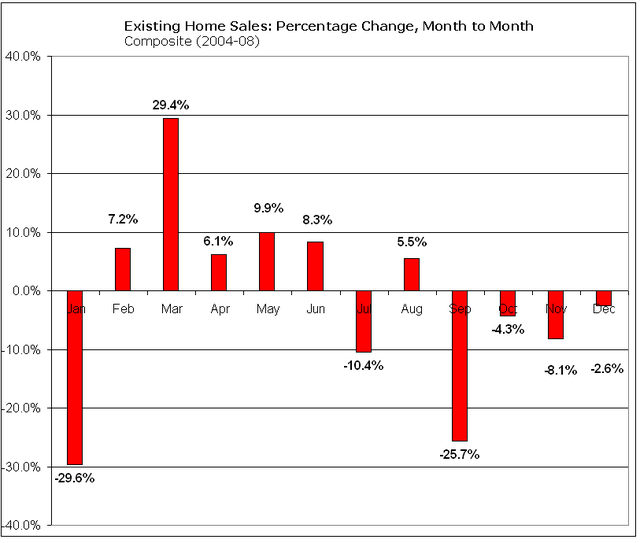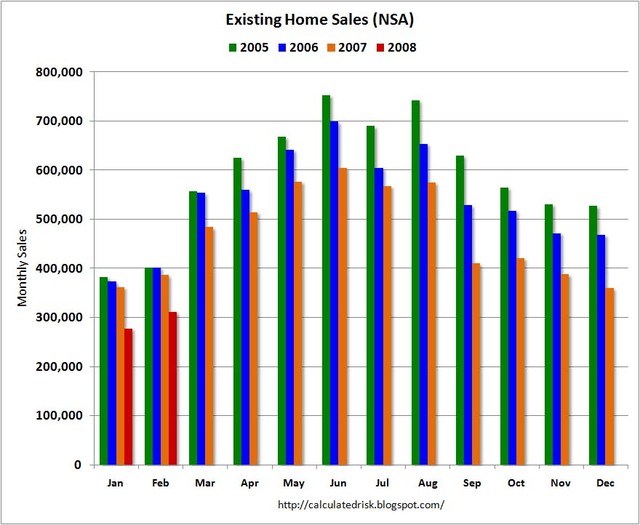A few other data points to note when considering the monthly changes (our earlier NAR Spin discussion):
>
1) February 2009 was a leap year — the month had an extra day, and without that I sincerely doubt we would have seen any gain (I wonder how they adjusted for that).
>
2) The Composite Monthly Sales for the past 4 years — non seasonally adjusted:
>
3) The average increase from January to February over the past 4 years has been 7.2%. Yesterday’s monthly “improvement” is less than half what we have been typically seeing.
Here’s what the percentage change from month to month looks like non seasonally adjusted:
>
4) Finally, here is the non seasonally adjusted data for the past few years. Note that for the past few years, February is ALWAYS better than January. March, April, May and June all see improvements also:
>
Special thanks to via Calculated Risk for the data runs . . .





If you charted hours of daylight against the above graphs you would see a nice match to the monthly trend, except December would be a bit lower than January.
It is not news that February has more hours of daylight than January.
Assuming they seasonally adjusted using X-12 ARIMA, the algorithm would have made the leap year adjustment automatically
The program is available to download here:-
http://www.census.gov/srd/www/x12a/
Barry, We aren’t in 2009 yet. Though it will be more of the same.
While, not an economist, I can probably predict with some certainty, just by looking at the Existing Home Sales (NSA) chart…
hmmm…
march will have an increase of about 30% from the february numbers… to about 400K.
however…
year over year…will show a decrease of about 17%.
how will the numbers be presented by the MSM next month…
hmmm…
I wonder.
February has more daylight hours than January!?!
Personally, I like the squirrel activity index (SQAI).
If when I get out in the early am for my morning exercise, the squirrels are busily hustling nuts, I know the humans will be also scurrying around looking for their own. Likewise, my SQAI shows a discernibly higher level of activity these past few weeks, which based on historical averages, is expected to increase month over month til June, then level off at a high pitch of activity until about October, when it will steadily decrease until about February.
One should almost always ignore the seasonally mal-adjusted data (regardless of the type of data). Give it to me straight.
So, if you add January and February of this year, you get a number that is waay smaller than Jan.-Feb. ’07, let alone ’06 and ’05. So we are on a pace to sell 25% fewer existing houses, and at lower prices–and the MSM just drinks the NAR KoolAid before reading off their press release. And Wall St. thought this was good news?
Seeing March’s always large increase, we are in for a very bullish report in less than a month. Not only will we have stabalized, but we will be off to the races again in home sales. Housing is the new oil.
http://news.yahoo.com/s/nm/20080325/us_nm/bearstearns_ebay_dc
by Reuters
Sold! Bear Stearns T-shirt gone for $151.76
Todays news for me was this.
I see a graph that clearly illustrates February sales are always higher than January sales.
It also shows that March is higher than February, May is higher than April, and so on. I think it proves that sales are higher in the first half of the year and lower in the last half. And that sales rise from January to mid year, and decline from mid year to end of year.
Stop the presses! Nobel prize required for bold new research! I think everybody always knew that housing sales increase at the end of the school year so that kids can be in their new district by Fall. This year was presumed to be the one that was different. So far, the doomsters are batting Zero.
So, since Feb is always better than Jan, and this Feb is higher than this Jan, then if March is higher than Feb, will this be absolute proof of a Realtor conspiracy? Or will it be suggestive of a housing bottom and mild sales recovery in housing units?
Let me guess … the gloomsters will say NO, not a recovery since sales are down so far from prior years. Well, Duh. So what. If sales go up relative to the bad times, then this is what is usually called ‘good news’ and ‘a possible recovery’.
I don’t usually like to feed the trolls, but here goes:
Hey cinefoz, I got yer housing recovery right here:
http://www.investingintelligently.com/wp-content/uploads/2006/08/a_history_of_home_values.png
A picture’s worth a thousand words.
No bottom until at least 2013.
Wrap your head around that.
And here’s another problem to solve, Sherlock. Housing sales were much higher in prior recent years due to the credit boom. Does that mean lower sales are indicative of a bust, or a return to normalcy? Are the current sales rates an overshoot on the downside to compensate for the excessive sales due to low interest rates and crooks in the mortgage market?
In other words, is comparing sales rates today with sales rates during the boom times of crooked mortgage credit, really honest, or is it a spin cycle, or is it just a simple mistake?
btw,
Anybody notice that 30-year Jumbo loan rates are at an eight-year high of 7.26% this morning?
That’ll really help clear the excess California inventory (rolls eyes).
Also, when the conforming ceiling of $417k was ‘raised’ a couple weeks ago for higher-cost counties, they also lowered the conforming ceiling for most lower-cost counties.
Few people have discovered this little ‘secret.’
I think the ‘foz has officially “jumped the shark”.
To put it in even more simple terms, The tulip market must still be in a deep depression since prices have never recovered to their old levels of a few hundred years ago. Ignore quantities of tulips grown, please. Rising quantities of tulips grown and sold are not proof of a recovered tulip market. Just ask anyone who subscribes to the theory of gloomster spin economics.
Cinefoz,
We aren’t doing YoY comps with boom times any more. The boom peaked in 2005.
That said, the wheels really came off the wagon later in 2007, so the 2008 comps should start getting easier in the fall.
yes Pool Shark……..some of us notice reality…..
ignorance is truly bliss for some.
Ciao
MS
I refuse to feed trolls, but cinefoz is really putting that resolution to the test.
Barry –
You state:
“C) The average increase from January to February over the past 4 years has been 7.2%. Yesterday’s monthly “improvement” is less than half what we have been typically seeing.”
I believe you are comparing Apples to Oranges. The 7.2% average Jan to Feb improvement is non-seasonally adjusted. The 2.9% I believe you are referring to as “Yesterday’s monthly ‘improvement'” is the seasonally adjusted number.
The non-seasonally adjusted Jan to Feb increase in 2008 from the NAR site is actually higher than the 2.9% – it is 12.2%. See the excel file at: http://www.realtor.org/Research.nsf/files/EHSreport.XLS/$FILE/EHSreport.XLS
So the February increase is higher than typical, in fact, nearly twice as high.
It would seem to me this analysis supports (albeit with only one small datapoint) the inference drawn from the NAR seasonally adjusted 2.9% increase that this Feb showed the slightest bit of an uptick.
Otherwise, as usual, great analysis.
Bob Abouey has this exactly right and says basically what I was going to say. I have a figure on my blog looking at the month-over-month change in SAAR for existing home sales since Feb 07. The uptick last month is a substantial change from the recent trend, which has been downwardly revised SAAR for the last 12 months.
See it here:
http://afferentinput.blogspot.com/2008/03/fed-existing-home-sales-bs.html
Are you trying to prove that the seasonal adjustment wasn’t done properly? It looks to me like the decline from Jan 2007 to Jan 2008 was larger than the decline from Feb 2007 to Feb 2008, meaning that there was in fact a seasonally adjusted increase.
There is a bigger story here though. If you look at the data in each month, it looks like sales dropped substantially for all months after March 2006, except for Jan+Feb 2007. In other words, last year Jan and Feb were seeing almost boom-like activity levels, even though housing had slowed down for the prior 9 months and the following 14+. It appears that the seasonal patterns are getting weaker as activity slows down.
If we assume that last Jan+Feb were normal and are showing a new seasonality pattern, then that would suggest that the housing market is much weaker than it appears. The June/Feb ratio went from almost 2 in 2005 to about 1.5 in 2007. If that happens again this year, the June number would be around 400k-450k.
The seasonal adjustment multiplier for February is about 17, but last year the correct number would have been between 13 and 14. If we apply that to this year’s Feb data, then the estimated number of homes to be sold this year is only about 4 million.
All of this is based on assuming a trend from one data point, so it could be completely wrong.
Looking at the NAR numbers, it looks like there will be nearly 5,000,000 houses in inventory comes summer. That represents (5M*$266K=) $1.33T money locked in housing, that isn’t available to get the economy going.
Further, at a 20% discount on house prices, that represents (5M*$266K*20%=)$266B disappearing into thin air.
And that is just the houses whose owners would like to sell. If you think about 130M households living in US, assuming half lives in single family housing (65M with avg price 266K), and the rest in apartments (65M with avg price 60K – which i conservatively made up), that tells me that 130M households, with average selling price of (65K*$266K + 65K*$60K =) $163K, and 20% haircut on the housing means $4.3T will just evaporate from the US HH wealth.
Whatever happened to the good old Moving Annual Total (MAT)?
Thank you Bob Abouey, afferent input – someone finally explained it correctly!!!
And for the earlier poster, NAR uses X-12 ARIMA model, so 29 days in february is not an issue for the seasonally adjusted data
http://www.realtor.org/Research.nsf/files/SAF_revisions.pdf/$FILE/SAF_revisions.pdf
In summary, who cares that year-over-year sales are down 23%, any genius would have guessed that based on the trend for the last 6 months. The fact that the month to month sales rate (after adjusting for normal seasonality) might actually be increasing is interesting news.
I doubt these are normal times, I’ll wait another few months before I start to believe we’re nearing a bottom in sales per month. Month to month numbers are always very noisy.
Lets see…
Fool me once, shame on me. Try to fool me 18 months in a row and you must be a NAR Economist.
OR
You can fool some of the people all the time, and all the people some of the time, but here is where NAR tries to make a liar out of Lincoln.
OR
How can you tell someone from NAR is lying …yes, their lips are moving.
Thanks …I’ll be here all week! :)
And by the way calling a bottom now is like calling a World Series winner after the first game…
We will be getting close to a bottom when the next 6 months of ARM resets default and are foreclosed on 6-12 months later.
Until then prices will continue to drop, inventories will continue to grow and bank losses will continue to rise.
I have not yet seen any comment about the regional distribution of February changes. Almost the entire national increase in seasonally-adjusted unit sales resulted from a dramatic increase (by 80K) in the Northeast. Unit sales in the rest of the country were up only 40K combined on a seasonally adjusted basis.
If you look at dollar sales (i.e., unit sales multiplied by average price per unit), the effect is even more dramatic. Seasonally adjusted, sales in the Northeast were up by $21.7 billion, while the rest of the country was down by $6.2 billion. Another way of looking at the data: the increase in unit sales for the rest of the country was entirely explained by sharply lower month-over-month prices (down 1.9% on average), but unit sales in the Northeast were up even though prices in the Northeast were essentially flat (down only 0.1%).
Does anybody have any ideas about what might have happened in the Northeast? Is this weather-related? Is the economy in the Northeast better than the rest of the country? Or is it just an statistical anomaly?
I suspect that there is a problem with the seasonal adjustment for the Northeast. If you look at the past four years, there has been a large increase in seasonally-adjusted February sales for the Northeast each year – by 40K in 2005, 130K in 2006, 120K in 2007 and now 80K this year. A housing bear might point out that this year’s increase is below the average for the last three years and far below average for the last two.
I don’t have figures for years before 2005, which are available from the NAR only on a paid basis. (They used to be available free.) But I wouldn’t be surprised to see a similar pattern in previous years.
Pending Home Sales Index falls 21.4%
I see that the NAR has hired Crackhead Bob as their new headline writer, to wit: Existing-Home Sales to Stablize Before Upturn in Second Half of 2008. In a moment, we will discuss how the NAR managed to get their forecast exactly backwards. Meanwhile, …
WSJ: “Inflation is back”
I’d like to point out a new feature in the usually astute WSJ: Printing erroneous information on the front page. Last month, in a front page, 3rd paragraph snafu, the Journal reported a 2.9% month-to-month change in existing home sales — a seasonal fa…